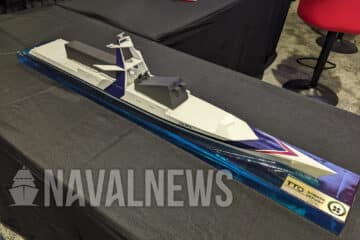According to the RSN statement, the event took place on 29 January 2021 off Singapore’ Southern Islands.
“It was exciting and satisfying to execute the deployment of a K-STER expendable mine disposal system (EMDS) against an underwater threat. After more than three years of development, and numerous rounds of planning and checks, we finally managed to achieve the successful launch and firing of an EMDS from an USV – a breakthrough in the deployment of USVs!”
MAJ Lim Yoong Seet, Head of Readiness and Resource Section, 6 Flotilla
The K-STER EMDS designed by French company ECA Group were previously used and deployed from the Bedok-class mine countermeasure (MCM) vessels. “But today, in a first-of-its-kind firing, a remotely controlled USV navigated to the identified location, launched an EMDS which closed in on the underwater threat and neutralized it” according to the RSN.
The mine warfare USVs of the RSN are known as the Venus 16. They were designed by Taiwan company Lung Teh with Singapore’s ST Engineering acting as systems integrator. The Venus 16 was introduced in 2017. We covered those USVs and their role in autonomous mine warfare during IMDEX Asia 2019. Here is our interview with the commander of RSN’s 194 Squadron:
Over the years, the RSN has been experimenting with unmanned systems for maritime security and mine countermeasure operations. “This is a prudent and necessary step for the RSN to optimise our limited manpower, at lower costs, to enhance our capabilities to safeguard Singapore and protect our vital sea lines of communication.” concludes the RSN.
USV and UUV Mothership concept: MRCV

In the future, the RSN plans to deploy these USVs from the Multi-Role Combat Vessel (MRCV). These new surface combatants will replace the ageing Victory-class Missile Corvettes, which have served with distinction since 1989. Delivery is expected to begin from 2025, with full delivery expected around 2030.
Besides improving capabilities, the new MRCVs will be custom-built for lean manning and incorporate technologies to automate certain functions. This results in the MRCV using less manpower – about half the size found in modern frigates. In addition, this will result in operational cost savings of up to 10 per cent, compared to similar-sized frigates.
The MRCV ability to act as mothership for unmanned systems is a new trend being adopted by many navies: As Naval News has reported in the past, the navies of Japan (30FFM), Belgium and the Netherlands are working on such projects, especially in the field of mine warfare. The Russian Navy recently experimented the same concept from one of its Project 22350 frigate while the U.S. Navy did the same with one of its Spearhead-class EPF. Last but not least, South Korea, the United Kingdom and France are actively working on this concept as well.
About K-STER

K-STER is a expendable mine disposal system developed by ECA GROUP in 2008. Inheriting from the successful PAP solution and benefitting from the latest technologies and R&D development, this Remotely Operated Vehicle is dedicated to underwater mine countermeasures. This sea proven solution allows to neutralise mine while keeping crew safe. Operators can run the drone from a command and control unit located outside of the minefield, whether onboard a ship or from the land – in this case, the K-STER can be automatically deployed from an USV platform.
Designed with tiltable shape charge, the K-STER can neutralise all kinds of mines from seabottom mines, floating mines, historical mines to the smartest mines. Its unique propulsion architecture allows to stand strong water currents and approach the mine to its closest. Safety characteristics includes insensitive ammunition & multi-pole safety interlocks until the final firing.
ECA Group’s K-STER solution is compliant to NATO standards thanks to the integration of the most advanced technologies in term of reduced acoustic and magnetic signatures.






